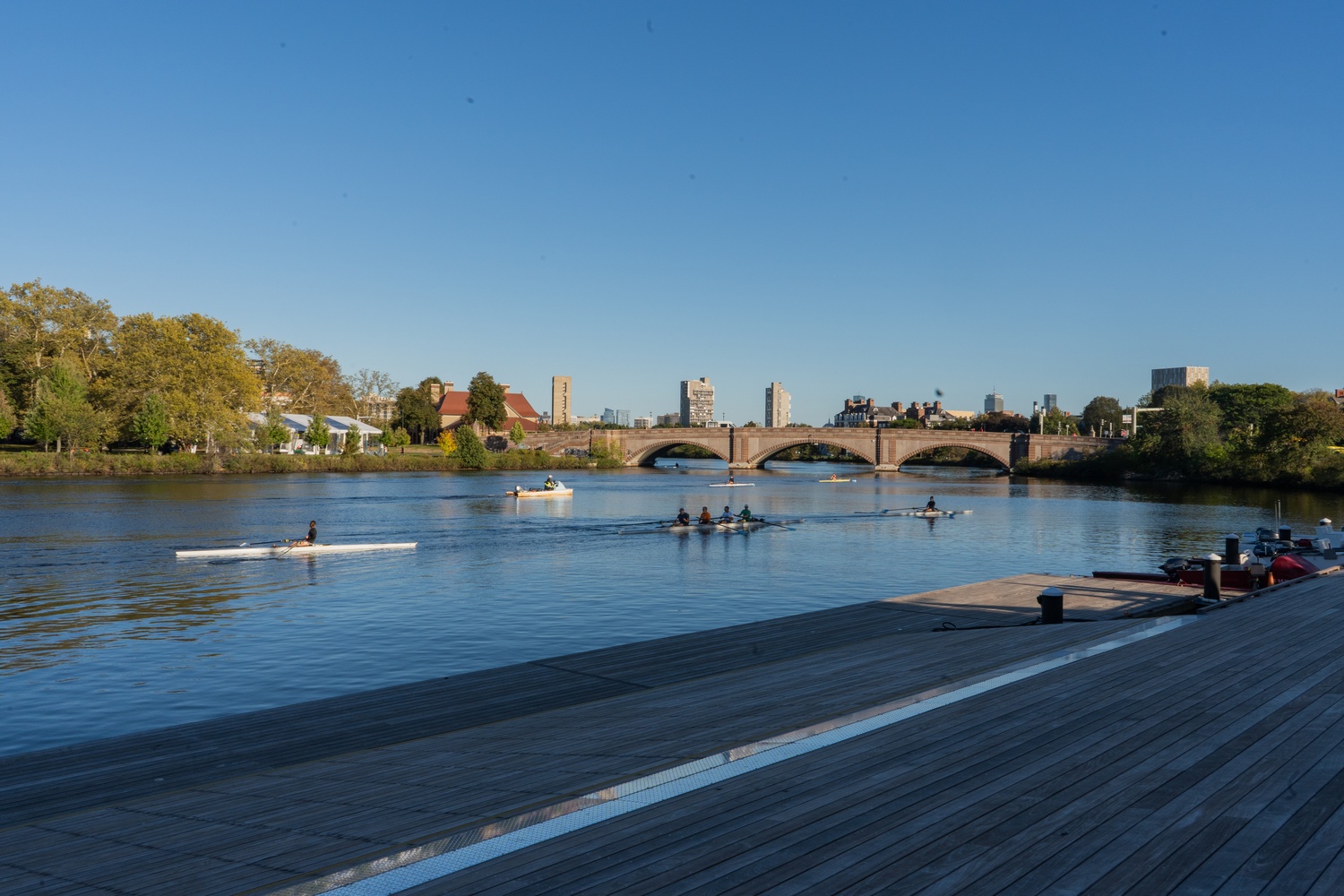
News
Summers Will Not Finish Semester of Teaching as Harvard Investigates Epstein Ties

News
Harvard College Students Report Favoring Divestment from Israel in HUA Survey

News
‘He Should Resign’: Harvard Undergrads Take Hard Line Against Summers Over Epstein Scandal

News
Harvard To Launch New Investigation Into Epstein’s Ties to Summers, Other University Affiliates

News
Harvard Students To Vote on Divestment From Israel in Inaugural HUA Election Survey
Views from the Boats

The Charles River runs for 80 miles throughout the cities and countryside of eastern Massachusetts. Spanning from Echo Lake in Hopkinton until it deposits its water in Boston Harbor, the Charles crosses historical landmarks and varied geography.
Every October, a three mile stretch between Cambridge and Alston steals the spotlight from the rest of the river. On the weekend of the Head of the Charles Regatta, crowds gather from around the globe to focus on a three mile stretch and the rowers occupying it.
While the racing is the main event, we recommend taking some time to take a step back and appreciate some of the beautiful scenery along the river as well as the elite rowers. Here is our mile-by-mile guide to some of the rowers’ favorite sights along the course.
Mile One
The three-mile long race commences at Boston University’s DeWolfe Boathouse, which sits on the north side of the river just southwest of Massachusetts Institute of Technology and across the river from BU. As soon as the race kicks off, crews immediately head to the Boston University Bridge, which is about a quarter-mile into the track.
As the crews push through under the bridge, they are surrounded by strokes of their past.
“We like to paint the bridges for big successes, so there’s a lot of paints from past years of our team,” Harvard senior lightweight rower Kyle Sutherland said. “That’s kind of when you really know you started the race.”
Once the crews make it past the bridge, they reach an open stretch where they make big pushes to try and gain time on their opponents. Just before they reach the River Street bridge, they pass the Riverside Boat Club, which was founded in 1869 and has seen the likes of Olympic and U.S. National Team rowers throughout its history.
Just before they reach the Western Avenue bridge, the first mile comes to an end.
Mile Two
The second mile of the regatta — sometimes referred to as ‘the powerhouse’ — is the busiest stretch of the race, especially for the representatives from Harvard. It starts with a sprint towards the John W. Weeks Memorial Bridge, which is both the first big turn as well as the place where crews start to really hear the spectators who have flocked to Cambridge for the weekend.
“There’s a lot of spectators on Weeks’, so you’re kind of getting more into the spectator area there,” Sutherland said.
After the turn by Weeks’, one of the two main boathouses for the Crimson sits on the north side of the river, and for the Harvard-Radcliffe rowing teams, passing this boathouse means more than anything.
“Weld Boathouse is definitely the most special part of the race,” Harvard-Radcliffe senior lightweight rower Kristine Schwartz said. “We always take some sort of special move, like a couple harder strokes, for Weld and for the people that are watching on the dock, which is our family, our friends, our coaches, [our] teammates.”
The crews then pass under Anderson Bridge, which connects the Allston neighborhood of Boston to Cambridge and is typically the most crowded by spectators every year. Just past Anderson sits the Newell Boathouse, the second main boathouse for Harvard and the training site for their men's crews.
“[Newell Boathouse] is where we row out of,” Sutherland said. “All of the alumni, coaches, parents, teammates, everyone is cheering from the dock, so that’s kind of a cool boost.”
After passing the boathouse, the crews finish the second mile and start their sprint to the finish.
Mile Three
The final mile starts with a straight path that sees few spectators and is the last quiet stretch of the race. After a few hundred meters comes the second big turn of the race, which passes around the bend towards Eliot Bridge, the final bridge of the race.
“That’s about 700 meters until the end, so that — to us — signals the start of the sprint,” said Schwartz.
With Eliot also being filled with spectators, it reminds the rowers how meaningful and historic this race is in the rowing world.
“It’s basically a packed course from start to finish,” Harvard senior heavyweight rower Ben Scott said. “That’s quite fun from an athlete point of view just because of the number of spectators you get at each of those checkpoints.”
“The bridges are always packed completely with people, which is really cool to see,” said Schwartz. “[It] gives us a sense of how big the whole regatta is. It’s more people than you ever imagine or expect.”
Just after the crews pass the Cambridge Boat Club and Belmont Hill Boathouse, the final stretch comes to an end, and the three mile race is finished after roughly fifteen action-packed minutes of rowing.
Even as the rowers soak in the crowds, they continue to think about bringing home some hardware for the Crimson. When asked about his favorite view from the boat, Scott mentioned both these elements of the race.
“Hopefully, it’s the increasing distance between whatever crew starts behind you, but second to that would be Newell and all the Harvard alumni and supporters on the dock as you come past,” he said.
—Staff writer Connor Castañeda can be reached at connor.castaneda@thecrimson.com.
—Staff writer Reed M. Trimble can be reached at reed.trimble@thecrimson.com. Follow him on X @ReedTrimble1.
Want to keep up with breaking news? Subscribe to our email newsletter.
